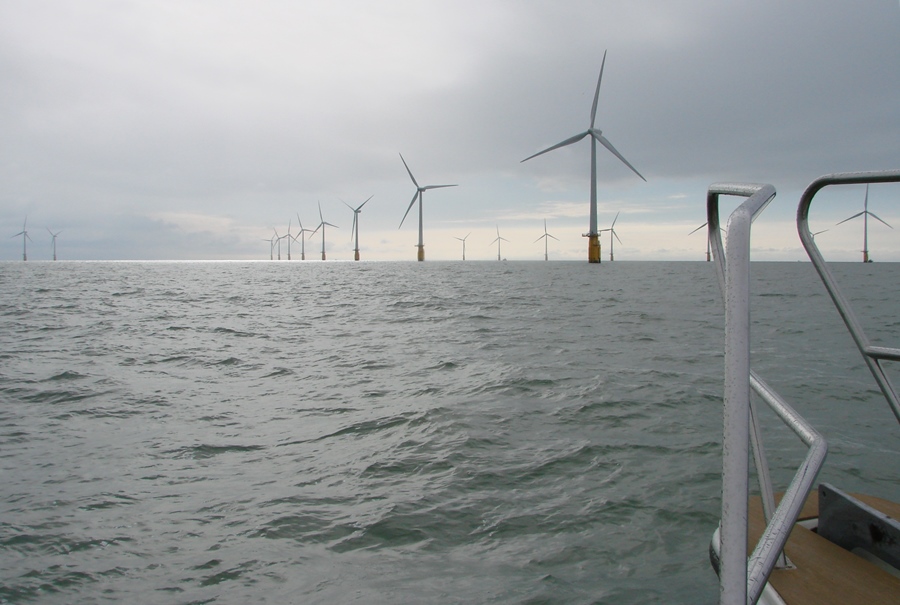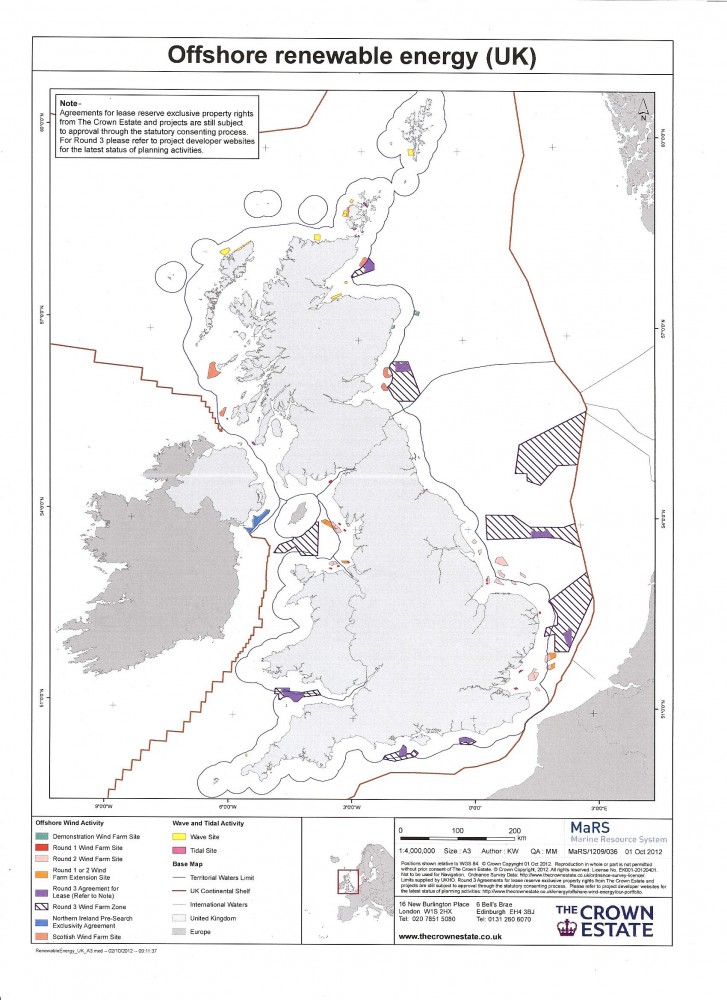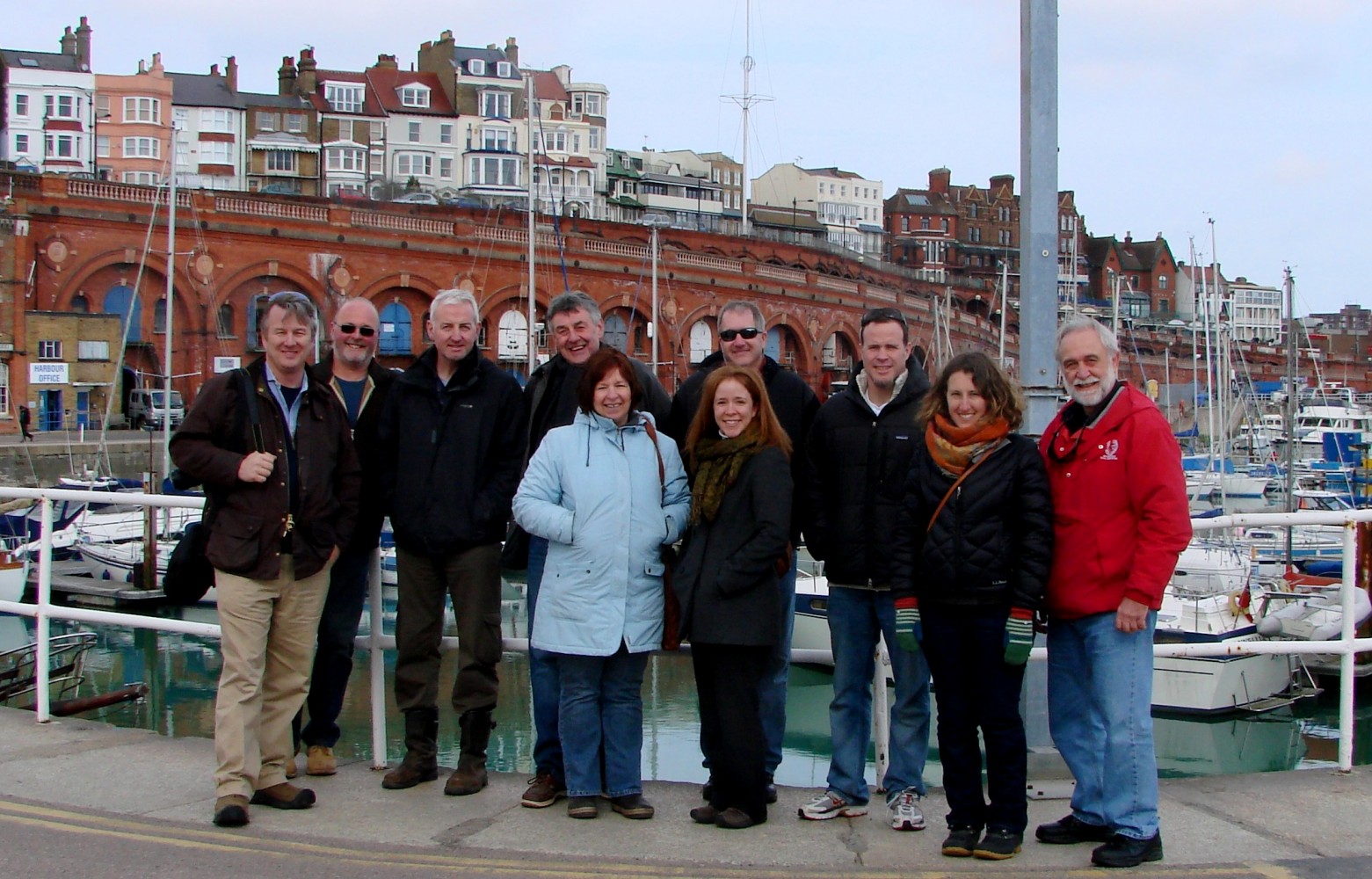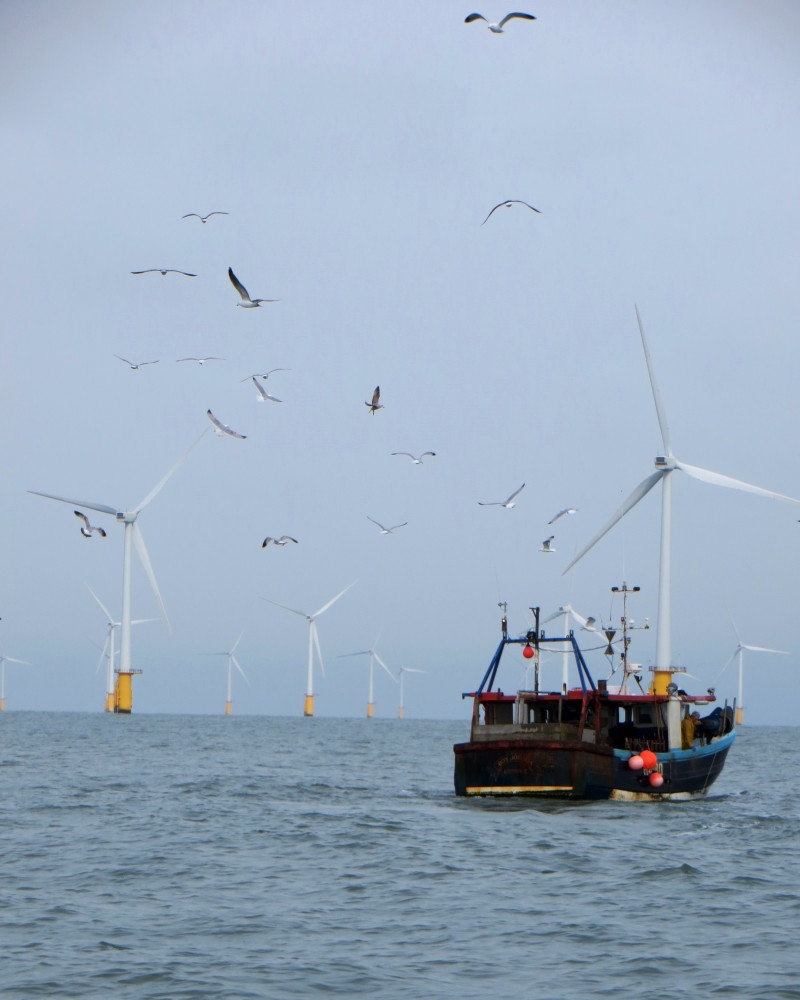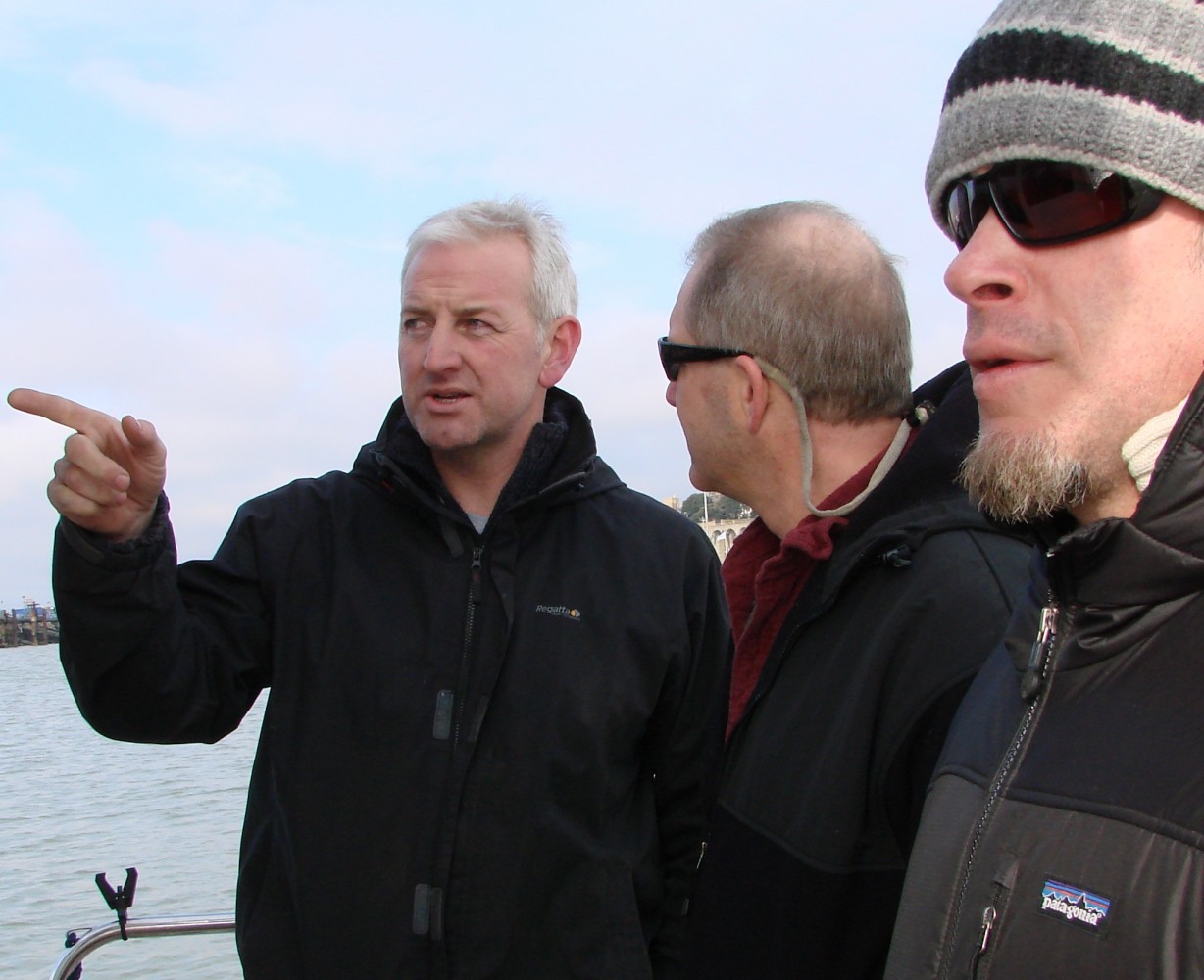England’s wind farm experience offers critical lessons for
US fishing industry
By Lorelei Stevens, editor; Commercial Fisheries News May 2013 www.fish-news.com/cfn
BROADSTAIRS, KENT – Looking out over the English Channel on a quiet night in March, the horizon is surprisingly ablaze with lights. A local fisherman quips, “People ask us if that’s France.”
It’s not. This illusion of a “city” of lights is the result of hundreds of enormous illuminated turbines in a string of wind farms located just off the southeast coast of England.
The United Kingdom (UK), which is made up of England, Scotland, Wales, and Northern Ireland, is racing to meet a European Union (EU) goal set in 2009 to generate 20% of the EU’s energy needs from renewable sources by 2020. Offshore wind energy is a big part of the UK’s strategy for keeping up its end of the bargain, and the speed at which wind farm construction has taken place has suddenly and irrevocably changed the lives of the inshore fishermen who once fished the waters the farms now occupy.
As of early 2013, a total of 25 wind farms, ranging in size from 30 to 216 turbines, were either under construction or operational in UK waters. In a number of areas, the farms are clustered or contiguous, intensifying the impact on fishing operations.
The learning curve for UK fishermen has been huge.
“The government went for a rapid and massive drive into ‘renewable energy’ through wind farms at sea and the fishing industry was left to catch up,” said Tom Watson, a former fisherman who now serves as a fishing industry representative for seven offshore wind farm projects.
Government officials, too, have been scrambling to figure out new siting and leasing procedures, how to rapidly assess environmental impacts, and how best to engage the public in planning processes to ensure that offshore wind farms are sited where they will do the most good – and the least harm.
Even energy companies have learned that relatively minor changes in their approaches to building offshore wind farms and opening up lines of communication can help build better working relationships with fishing communities.
Northeast US next
Here in the Northeast US, offshore wind energy development is about to take off. Between the Obama Administration and a number of states, the path already has been cleared for the construction of up to 23 wind farm projects between Maine and North Carolina.
And, on April 16, the administration announced adoption of the National Ocean Policy Implementation Plan, which streamlines federal decision-making and permitting processes and formalizes a “Coastal and Marine Spatial Planning Initiative” that some describe as “ocean zoning.” Clearly, industrial development of the waters off our coast is closer to becoming a reality than ever before.
The Ocean Conservancy (OC), a Washington, DC-based environmental group, has made a commitment to promoting “smart ocean planning.” The goal is to ensure that offshore renewable energy development proceeds in a way that avoids conflict with marine life, the ocean environment, and ocean-dependent industries – including commercial and recreational fisheries – that support millions of jobs and generate billions of dollars in economic activity for the nation.
As part of that initiative, OC sponsored a March 16-21 fact-finding trip to England so that a group of individuals involved in fisheries here in the Northeast could learn more about how fishermen and regulators there are dealing with offshore wind energy development.
John Williamson of Kennebunk, ME, a former member of the New England Fishery Management Council and consultant, planned the trip. The result was five intensive days of meetings with English fishermen, fishing industry and energy company representatives, and UK and EU government planners, and a first-hand visit to the Thanet Offshore Wind Farm, a 100-turbine operation that stretches from the seaside town of Broadstairs to the port of Ramsgate. In addition to Williamson, other members of the team were: Rick Bellavance, a Rhode Island charter boat captain and fisheries liaison for a wind farm proposed in state waters; John McMurray, an outdoors writer and owner of a charter boat that operates outside of New York City; Michele Hallowell, an attorney with the Washington, DC-based law firm Kelley, Drye & Warren that represents fishing industry groups; Rick Robins, a Virginia seafood company owner and chairman of the Mid-Atlantic Fishery Management Council; Meredith Mendelson, deputy commissioner of the Maine Department of Marine Resources, who serves as the state rep on two regional ocean planning organizations; and Lorelei Stevens, editor of Commercial Fisheries News.
Sandra Whitehouse, senior adviser for national conservation policy and legal affairs for The Ocean Conservancy, explained OC’s decision to support the trip this way.
“Wind structures are new for us here in the US. Our goal at the Ocean Conservancy is to support the development of a comprehensive ocean plan so we put them in the right place,” she said. “We recognize that commercial and recreational fisheries are a priority activity, and we wanted a group of influential people from these regions to learn about that country’s planning process and draw their own conclusions.”
In short, the team learned that: effective ocean planning is complex and requires full and honest public participation; fishing in and near wind farms is difficult for most kinds of fishermen; allowing fishermen and energy developers to work together independent of government constraints is critical; and the impacts of wind farms on fish stocks and the marine environment are largely unknown.
In the months to come, CFN, with the help of other team members, will share the lessons learned during the England trip in more detail. Stay tuned, because, as Mendelson put it, “The fishing industry needs to be engaged early and often. Very early and very often.”
Wind farm advice: Accept, engage, negotiate
Lorelei Stevens, editor, Commercial Fisheries News, June 2013 www.fish-news.com/cfn
LONDON, ENGLAND – Over the last few years, European fishermen have been forced to grapple with the sudden reality of wind farm construction on their fishing grounds. Their experiences offer important lessons for fishermen here in the Northeast.
In mid-March, a team of people involved in fisheries in this region traveled to England to learn how offshore energy development is unfolding there (see CFN May 2013).
The five-day trip, sponsored by Ocean Conservancy, included meetings with a number of fishermen and fishing industry representatives impacted by offshore energy development.
Across the board, they had several loud and clear messages for US fishermen. The first was perhaps best summed up by Tom Watson, a former fisherman who now works as a fishing industry representative for seven offshore wind farm projects in the United Kingdom (UK).
“A lot of fishermen wonder, ‘Can they really build the wind farms?’ The answer is they can and they will,” he said. “There’s been a lot of angry second guessing, which is a waste of time. They’re going to do it and, if you stand in the way, you’re going to be a casualty.”
The next step is to create, as early as possible, a clear line of communication directly between fishermen and energy developers – without government involvement.
Engineer Andy Revill, who is well known in international fishing gear technology circles, was hired by DONG Energy last year to engage with the fishing industry on behalf of the Scandinavian company.
DONG operates four offshore wind farms in the UK and is a partner in the 175-turbine London Array, the world’s largest operational offshore wind farm.
Without honest and direct dialogue, Revill said, most energy developers will be unaware of how the siting, construction, and operation of a wind farm might affect local fishermen.
“As a company, DONG has strong moral standards and a responsible attitude,” he said. “But, basically, it’s a group of engineers who like to build things. They don’t understand the issues.”
In the UK, issues for fishermen have included being shut out of traditional fishing grounds during wind farm construction and then trying to figure out if and how they can safely and practically resume fishing in and around the farms once they are built.
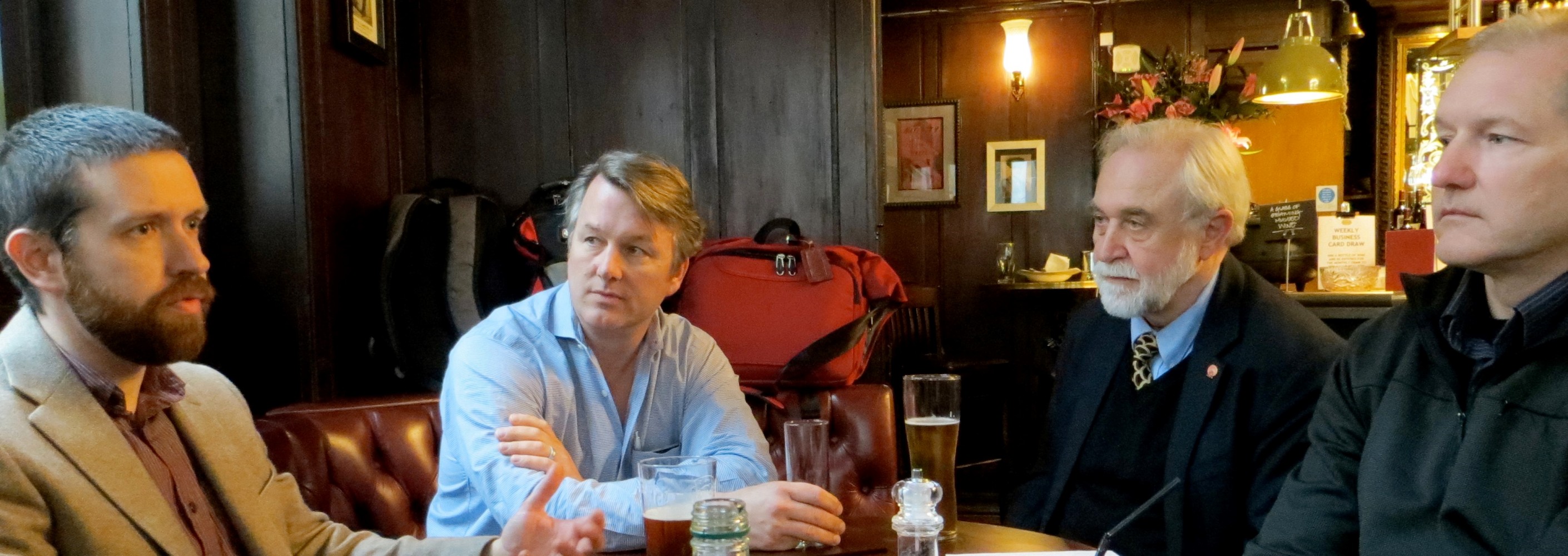
Mike Cohen, Holderness Fishing Industry Group, speaking with Robins, Williamson and Bellevance in London.
Lorelei Stevens photo.
“Cables float free and come down on pot trawls,” said Mike Cohen, CEO of the Holderness Fishing Industry Group, which represents dealers, processors, and fishermen involved in the European lobster fishery.
“There are impacts outside the farms, too,” he added. “Sediments dug up during trenching to bury cables have traveled outside farm parameters, smothering the bottom. Not only did this kill off the lobster stocks living in the area at the time, but it also covered habitat features that made the area suitable for lobsters in the first place.”
One positive result of having good communications is that the energy company eventually heard and understood some of these concerns.
“DONG has proposed changing drilling practices to contain the kicked up sediment by placing a ring of stone around the trenching area,” Cohen said. “It’s encouraging to see that come from DONG.”
Mitigation
However, many side effects of wind farms remain costly for fishermen, and the other goal of establishing relationships with energy developers should be negotiating mitigation agreements.
“Instead of looking for cash, look for something that will help you make a living,” Watson urged.
The Ramsgate-based Thanet Fishermen’s Association has dealt with the construction of two wind farms in its backyard – the Thanet Offshore Wind Farm and the London Array.
As part of a mitigation package, energy developers agreed to install fast-flow pumps at the association’s fuel co-op dock and then purchase fuel from the co-op for its service vessels.
Mitigation measures offered by UK energy companies have included direct compensation to fishermen for earnings lost during construction. Developers also may agree to hire local fishing vessels to assist with surveys and monitor construction areas.
Energy companies can create funds to compensate fishermen for lost or damaged gear, pay for vessel upgrades or retraining, and more. They also establish “community benefits funds” that local communities can tap to fund school, renewable energy, and other projects.
Cohen, too, stressed that the goal in negotiating a mitigation agreement should not be a big cash payout, but something more long-term.
“My interest is not to have people move out of fishing. It’s the only major employer in my region, and there are strong cultural ties to fishing,” he said. “Compensation isn’t the point. Fishermen don’t go fishing to make a certain amount of money. They go fishing to try to make a living.”
Honesty, unity
Fishermen and industry reps in England had two other pieces of advice for fishermen here in the Northeast – participate fully and honestly in efforts to identify traditional fishing grounds, and get organized.
“Only a few fishermen participated in a brief mapping survey conducted for the London Array,” said Thanet Fishermen’s Association treasurer Merlin Jackson. “The conclusion was there were no fish there and no fishing action. That wasn’t right.”
Unity is important, too. “Be one. Speak as one,” said Ramsgate fisherman John Lowe. “If you’re fragmented, they’ll pick you apart one by one, chew you up, and spit you out.”
Jackson offered this final message to Northeast fishermen.
“Being well organized in as large a group as possible with sensible, pro-active leadership is an important starting point,” he said. “And develop a strong awareness of how the planning process works. At the earliest point at which fishermen can be involved, give input regarding the areas concerned. It is important that your fishermen realize what a very real thing this is and do not wait for the first ship to turn up before becoming active.”
Lorelei Stevens
Gulf of Maine: Urban Sprawl; Managing Crowded Waters
By Kerry Crisley – Nature Conservancy
“Over there! There, there!!”
Sally Yozell, a marine conservation director for The Nature Conservancy, is the first to spot the humpback whale.
I shriek — yes, as if I am six years old — when I see the mammal bend her back in an impossibly acute angle and dive, waving goodbye with her fluke. She’s dining on sand lance, a fish rich in fat that is found here in abundance.
It’s a warm, sunny day, and Yozell and I are on the Sea Keeper with John Williamson, a former fisherman from Maine. We’re in the Stellwagen Bank National Marine Sanctuary, a 638-square mile area that Williamson calls “the ecological jewel of the Gulf of Maine.”
Read the whole story on Nature.org >>
Zoning Busy Ocean Waters to Avoid Conflicts
By Richard Harris
August 10, 2009
In the traffic lane
Anyone who has tried to dodge around Boston’s notorious streets can tell you that the city is one bustling place. But it might come as surprise that the same can be said for the waters that extend off Boston’s shore, out into Massachusetts Bay.
The oceans may seem endless, but in fact we’re starting to run out of elbow room. Now, both the federal government and the state of Massachusetts are making plans to zone the oceans, much as planners zone our cities.
Instead of trying to allocate space for schools and skyscrapers, ocean planners are trying to keep harmony between fishermen, wind farmers, aquaculture developers, freighter traffic and, of course, the rich sea life that depends on this space.
To tell this story, Sally Yozell of the Nature Conservancy has invited us out to sea with her friend, Capt. John Williamson.
Read the whole story on NPR.org >>
Fleet in port
The Future of Fishing
By Laura Knoy on Thursday, February 25, 2010 – New Hampshire Public Radio LISTEN on NHPR.org>>
Federal regulations continue to tighten fishing quotas for New England’s small fisheries, and some fear the measures could put half of the state’s fishing boats out of business. The concern was enough to launch a march on Washington yesterday to seek congressional support for family fishermen. We’ll look at the new regulations and the effect they could have in New Hampshire.
Guests
- John Williamson, consultant in sustainable fishing, longtime commercial fisherman, former member of the New England Fishery Management Council and owner of the Sea Keeper charter boat
- Erik Anderson, president of the New Hampshire Commercial Fishermen’s Association, former member of the New England Fishery Management Council and a longtime fisherman
We’ll also hear from
- David Goethel, longtime New Hampshire fisherman and member of the New England Fishery Management Council; he was the lone dissenter in the recent vote to overhaul fishing regulations for the region
- Sally McGee, New England fisheries policy director for the Environmental Defense Fund
The Fate of Our Fish
By Laura Knoy on Wednesday, February 18, 2009 – New Hampshire Public Radio LISTEN on NHPR.org >>
After years of dwindling fish populations, anew report from the UNH shows some success stories in our seas. Certain fish stocks are up and scientists feel more confident that sustainability could be a reality in the future. We’ll look at the state of our region’s fishing industry.
Guests
* Andrew Rosenberg director of the Ocean Process Analysis Laboratory at the UNH Institute for the Study of Earth, Oceans, and Space, former dean of the College of Life Sciences at the University of New Hampshire and former northeast regional administrator for the National Marine Fisheries Service
* John Williamson, fish conservation manager for the Ocean Conservancy, former member of the New England Fishery Management Council and formerly a fisherman for 20 years
We’ll also hear from
* Erik Anderson, president of the New Hampshire Commercial Fishermen’s Association
